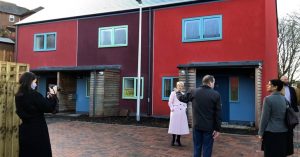The UK’s zero-carbon ‘paradigm shift’ in large-scale, affordable housing
“Passivhaus is really not complicated, and it doesn’t have to cost more than conventional construction.”
.
Passivhaus construction can be very impressive:
Passivhaus East Devon – Vision Group for Sidmouth
But it can also be on a large scale and not expensive:
Affordable Passivhaus in Somerset – Vision Group for Sidmouth
And it’s been happening in Exeter:
Exeter affordable Passivhaus homes win award – Vision Group for Sidmouth
.
Oliver Wainwright, the Guardian’s architecture correspondent, takes a look at these projects:
.
Eco-homes become hot property in UK’s zero-carbon ‘paradigm shift’
Smart, low-carbon homes were once the preserve of one-off grand designs – now there are up to 30,000 projects in the pipeline
Exeter city council, for example, has been quietly building zero-carbon homes for the last decade, with more than 200 council houses built so far to the exacting Passivhaus low-energy standard, and 1,000 more in the pipeline.
“We were originally driven by trying to address fuel poverty,” says Emma Osmundsen, director of the council’s housing company, Exeter City Living. “Not many people were talking about climate change in 2009, when we built our first three Passivhaus homes, so we became a kind of accidental pioneer.” The council is now on the seventh generation of its low-energy house design, which it has honed over the years to make it as “idiot-proof” as possible, says Osmundsen. Rather than timber frame, they use clay blocks that slot together like Lego bricks and contain a honeycomb of air pockets, negating the need for additional insulation. The homes are so thermally efficient that 60% of the tenants haven’t had to switch on their heating at all – some for more than 12 years.
Like many in the industry, she thinks the biggest barrier to wider adoption of low-energy standards is the lack of care and attention to detail on British building sites. “Passivhaus is really not complicated, and it doesn’t have to cost more than conventional construction,” she says. “It’s a bit like baking a cake: most of the ingredients are the same as a regular house, but you just have to follow the recipe in the right order. Perhaps it’s because the building industry is so male-dominated, but there is a general reluctance to follow the recipe.”
Many other councils are following Exeter’s lead…
Eco-homes become hot property in UK’s zero-carbon ‘paradigm shift’ | Architecture | The Guardian
.
The piece then goes on to look at projects in Norwich:
.
 To return to Exeter, though, it is both impressive what is being done:
To return to Exeter, though, it is both impressive what is being done:
And, indeed, stunning:
Stunning new Passivhaus council homes unveiled in Exeter – Exeter City Council News
photo: Exeter City Council and Hockings Green